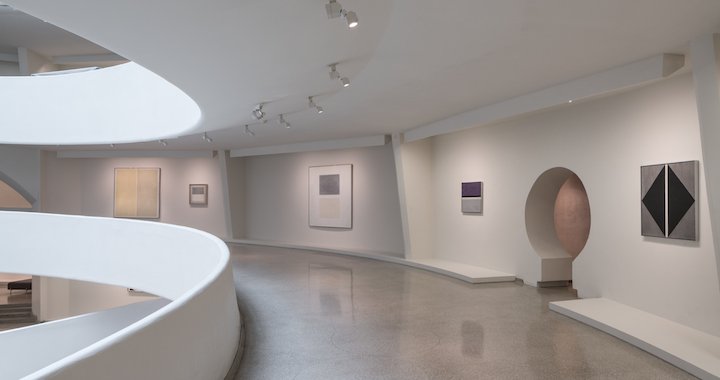
John Zorn: Music for Agnes Martin
Weronika Trojańska
01/12/2016
John Zorn: Music for Agnes Martin
Solomon R. Guggenheim Museum, New York City
Thursday, December 1 and Friday, December 2, 2016
When the retrospective exhibition of Agnes Martin, an American abstract painter, was about open in early October at the Salomon R. Guggenheim in New York City, many people were very skeptical of how her compositions of striped and gridded canvases would fit into the curved-shaped, organic architecture of the museum. How Martin’s meditative paintings would co-exist with a Frank Lloyd Wright design – a building whose circular construction not only dominates the space, but even just walking through its spiral ramps make one’s head spin. Even the prominent art critic of “The New York Times”, Peter Schjeldahl, expressed his anxieties: “That’s something of a surprise: no setting would seem less congenial to the strict angles of Martin’s paintings than the curves of Frank Lloyd Wright’s creamy seashell.[1]”
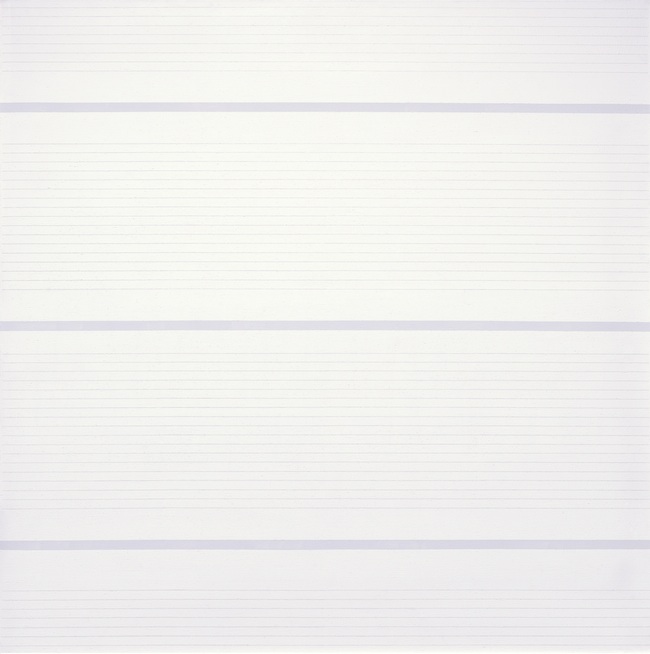
Agnes Martin. Untitled #15, 1988. Acrylic paint and graphite on canvas, 182.9 x 182.9 cm. Museum of Fine Arts, Boston, Gift of The American Art Foundation in honor of Charlotte and Irving Rabb, 1997. © 2015 Agnes Martin/Artists Rights Society (ARS), New York
Surprisingly (Schjeldahl admits this in his text later as well), this combination works really well. The ostensibly odd interior, in fact, intensifies the material qualities of the works, as well as becomes a metaphor for Martin’s psychological turbulences.
For over forty years, until she passed away twelve years ago at the age of 92, she lived with diagnosed schizophrenia. Martin painted with her “back to the world”. Her non-figurative paintings are not about what surrounds us. “Every day for twenty years I would say: what am I going to do next? That’s how I ask for inspiration. I don’t have any ideas myself (…) only what the inspiration calls for,[2]” the artist confessed in an interview with Chuck Smith in November of 1997. “First, I have the experience of happiness and innocence. Then, if I can keep from being distracted, I will have an image to paint[3]”. Martin pointed very often (also in her writings) towards the importance of happiness and joy in the process of creation. The happiness that comes out of solitude. “The best things happen to you when you are alone,” she said.
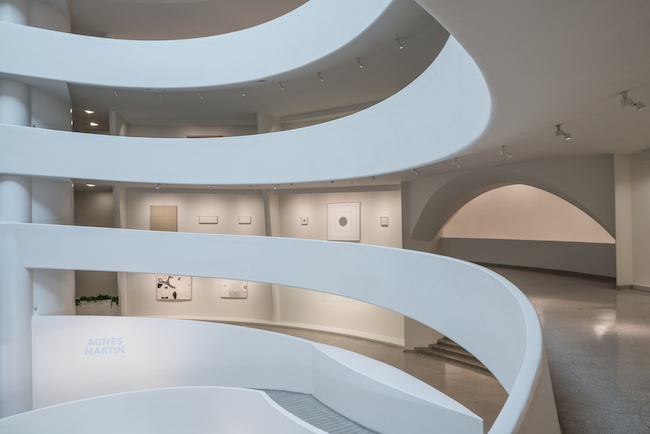
Installation View: Agnes Martin, Solomon R. Guggenheim Museum, New York, October 7, 2016– January 11, 2017. Photo: David Heald © Solomon R. Guggenheim Foundation
Her paintings pulsate with light colors as if they were illuminated from the inside, within the pigments of the paint. The colors seem to be fading on the canvas in front of the viewer’s eyes, intensifying the geometrical grids and striped shapes on the surface. Paraphrasing the narrator in Chris Marker’s Sun Soleil,[4] if you don’t see happiness in the pictures, at least you see beauty.
The pastel-stripe patterns of the paintings echo the architecture of the ramps. The tones of the canvas, in combination with the museum’s walls that have been painted in subtle colors, create a harmonic mosaic of shades. Against this background, the golden painting Friendship (1963) – shining like a shrine in a temple – emerges as the only quite distinct accent. Everything exists in harmonic symbiosis. It feels almost unearthly, a sensation that can only be compared to the listening of music.
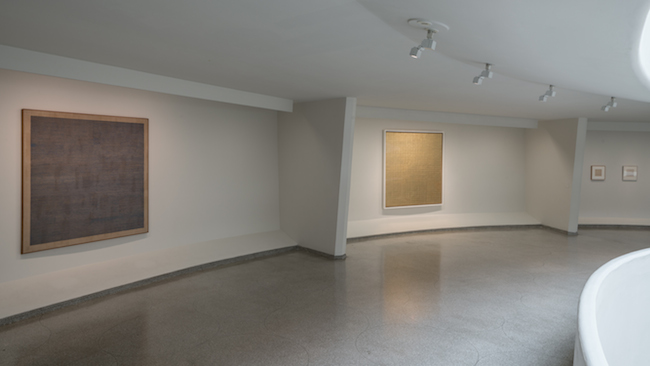
Installation View: Agnes Martin, Solomon R. Guggenheim Museum, New York, October 7, 2016– January 11, 2017. Photo: David Heald © Solomon R. Guggenheim Foundation
“The obedience of performing musicians is extremely sensitive and accurate. There is no way to describe reward of absolute obedience. Any response to art is obedience”, wrote Martin in What is real[5]. For her, music was the highest form of art. “It really is abstract”, she said.
In 1995 the artist created seven paintings especially for The Harwood Museum of Art in Taos, New Mexico (where she moved to in 1993 and lived until her death), which became home to the octagonal-shaped Agnes Martin Gallery. The subtle horizontal stripes on the canvases, gently insulated with pencil marks, trace her subtle conversion from biomorphic shapes to linear grids, which often resemble musical staves.
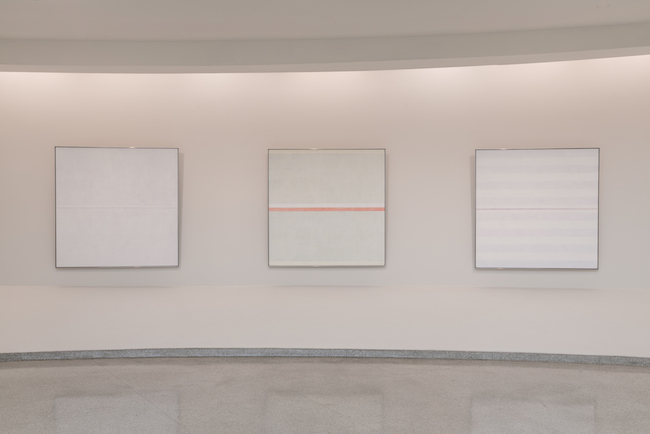
Installation View: Agnes Martin, Solomon R. Guggenheim Museum, New York, October 7, 2016– January 11, 2017. Photo: David Heald © Solomon R. Guggenheim Foundation
In September of the same year, legendary American eclectic composer John Zorn released his album “Redbird”, as inspired by the work of Agnes Martin. Indeed, the artwork and the music share a joint sensibility. The “breathing” quality of Zorn’s slow, almost monotonous compositions is often compared to the work of another composer, Morton Feldman. The title piece, “Redbird” (41’01”), scored for viola, cello, harp and percussion, brings to mind passages of chamber-orchestra concertos in which the treble vibrates over somber background music. The high pitches of sound stretch in the air, like chords of pencils on Martin’s paintings. The other, shorter composition on the album – “Dark River” (8’52”) – has quite different overtones with its swooshing sound of rumbling drums, almost like thunder approaching from afar. It is timeless, as it has started before anyone could hear it, and it will never end – it stops. “Zorn's most beautiful moments have been those rare examples of stasis, when he reaches a territory and allows himself to observe instead of quickly disrupting it.”[6] Experiencing his music may touch upon similar sensibilities as when encountering the monochromatic paintings by Agnes Martin, who said that “the musical composer listens. He doesn’t think about structure. So you must say that my work is not about structure.[7]”
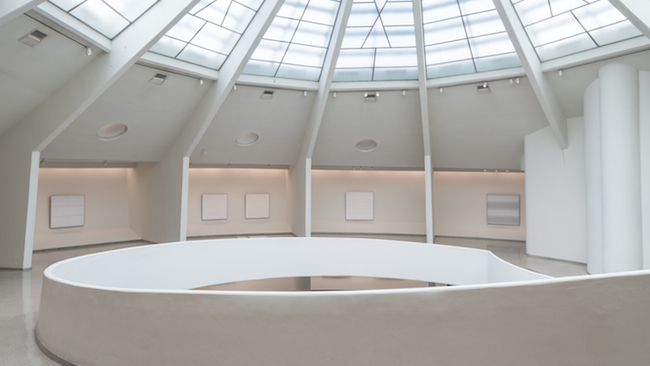
Installation View: Agnes Martin, Solomon R. Guggenheim Museum, New York, October 7, 2016– January 11, 2017. Photo: David Heald © Solomon R. Guggenheim Foundation
Twenty years after its creation, in the beginning of December, at the iconic rotunda of the Guggenheim Museum in New York, John Zorn, together with a cast of musicians, will perform “Dark River”. That same evening, two new pieces inspired directly by Martin’s work – “Praise” and “Blue Stratagem” – will be premiered. “See if you can discover your true feelings when listening to music. Make happiness your goal.[8]”
[4] “He wrote me: one day I'll have to put it all alone at the beginning of a film with a long piece of black leader; if they don't see happiness in the picture, at least they'll see the black”, says the narrator at the beginning of Chris Marker’s “Sun Soleil”.
[5] Agnes Martin, Writings, Kunstmuseum Wintenthur / Edition Cantz, p. 96
[6] John Zorn, Redbird, review by Brian Olewnick, The Squid’s Ear, 20/08/2003, www.squidco.com
[8] Agnes Martin, Writings, Kunstmuseum Wintenthur / Edition Cantz, p. 155